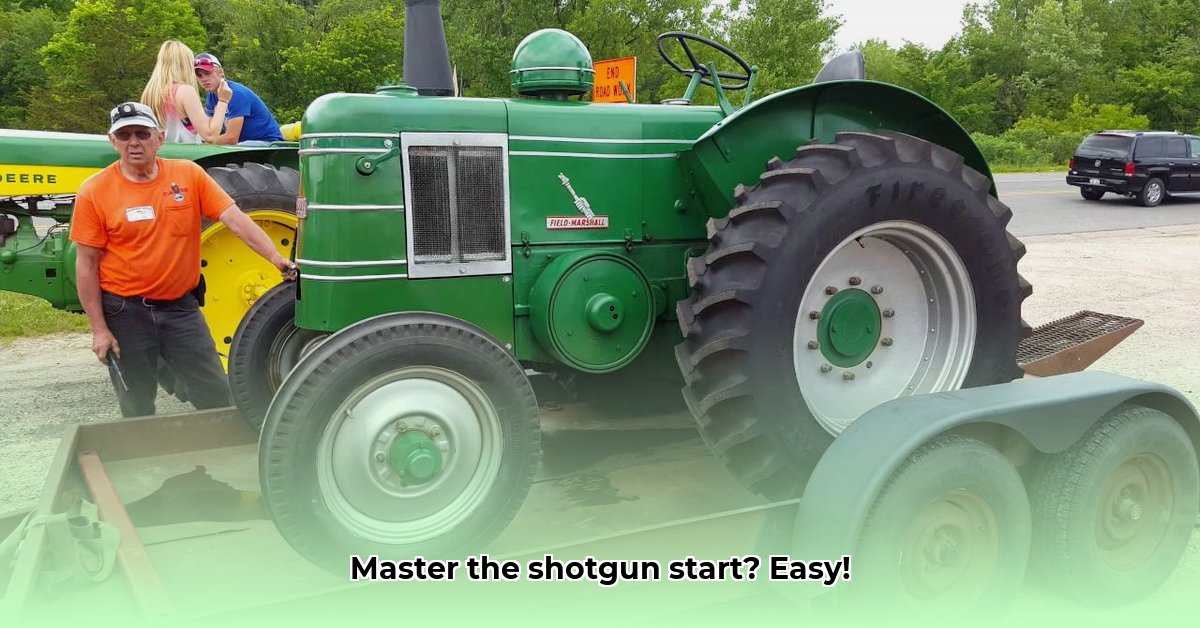
Starting Your 1948 Field Marshal Tractor: A Comprehensive Guide
Firing up a vintage 1948 Field Marshal tractor is a unique experience. This guide details the two primary starting methods: the traditional hand crank and the distinctive shotgun start. We'll cover the history, mechanics, safety protocols, and troubleshooting for both, ensuring you get your tractor running smoothly and safely. This guide focuses on preventing engine damage while also prioritizing the safety of the operator. For more details on shotgun starts, see this helpful resource: Shotgun Start Details.
Hand-Cranking Your 1948 Field Marshal: The Tried and True Method
The hand crank is the classic approach, relying on manual effort. It's straightforward but requires strength and skill.
Step 1: Engine Preparation: Before cranking, prepare the engine. Add a squirt of oil to the cylinders (this lubricates internal components). Check the glow plug (this assists ignition) to ensure it's functioning correctly. Proper preparation ensures a smooth start.
Step 2: Piston Positioning: Align the piston near the top of its stroke (Top Dead Center or TDC). This is when the piston is at its highest point. Incorrect positioning can lead to a difficult start or damage. Accurate positioning is critical.
Step 3: Engaging the Crank: Insert the hand crank. Turn slowly and firmly, working against engine compression. Don’t force; a controlled motion is more effective.
Step 4: Starting the Engine: As you crank, you'll feel the engine begin to catch. Maintain a consistent speed until it roars to life. Patience is crucial.
Troubleshooting Hand-Cranking: If the engine won't start, recheck the glow plug, engine lubrication, and fuel system. A poorly prepared engine will be difficult to start.
The Art of the Shotgun Start: A Blast from the Past (and a Safety Primer)
The shotgun start, a testament to innovative (if unconventional) engineering, uses a blank shotgun shell to ignite combustion. Extreme caution is paramount. This is not to be taken lightly.
Step 1: Engine Preparation: Prepare the engine meticulously. Check the glow plug and add oil. Proper preparation minimizes misfires and damage.
Step 2: The Shell and Mechanism: Use only specially designed blank shotgun shells, never live ammunition. Insert the shell into the designated mechanism. Understand the mechanism completely; a mistake can be dangerous. The design varies by tractor model; research is crucial.
Step 3: Initiating the Start: Safely fire the shell. This creates pressure to ignite the engine cylinders.
Step 4: Monitoring: Monitor the engine's response. It may sputter initially, requiring minor fuel adjustments. Never tamper with the firing mechanism while the engine is running or the shell is present.
Comparing the Methods: A Side-by-Side Look
| Feature | Hand-Crank Starting | Shotgun Starting |
|---|---|---|
| Starting Speed | Slow, requires effort | Fast, less physical effort |
| Physical Demands | High | Lower |
| Safety | Moderate risk; hand injuries possible | High risk; potential eye injury, misfires |
| Skill Level | Requires practice | Requires practice and safety knowledge |
| Required Tools/Items | Hand crank | Blank shotgun shells, specialized mechanism |
Maintaining Your 1948 Field Marshal: For Longevity
Regular maintenance is key: change oil frequently, inspect for wear, and address issues promptly. A well-maintained engine is less likely to have starting problems.
Safety Precautions: A Critical Reminder
Both methods carry risks. Prioritize safety:
- Hand Crank: Avoid hand injuries. Maintain a firm grip and avoid sudden movements.
- Shotgun Start: Use only blank shells. Wear eye protection. Follow all firearm safety regulations.
Troubleshooting and Maintenance
If the engine fails to start:
- Hand-crank: Check fuel, spark plug, and compression.
- Shotgun start: Ensure proper shell modification and a clear mechanism.
Consult a repair manual or mechanic if needed. Regular maintenance (oil changes, spark plug checks, fuel line cleaning) extends engine life and prevents problems.
Conclusion: Respecting History, Prioritizing Safety
The 1948 Field Marshal tractor, with its unique starting methods, represents a fascinating chapter in agricultural history. Mastering both starting methods, prioritizing safety, and performing regular maintenance will ensure the long and safe operation of this classic machine. Remember, respecting the history of this machine and handling it safely are paramount.